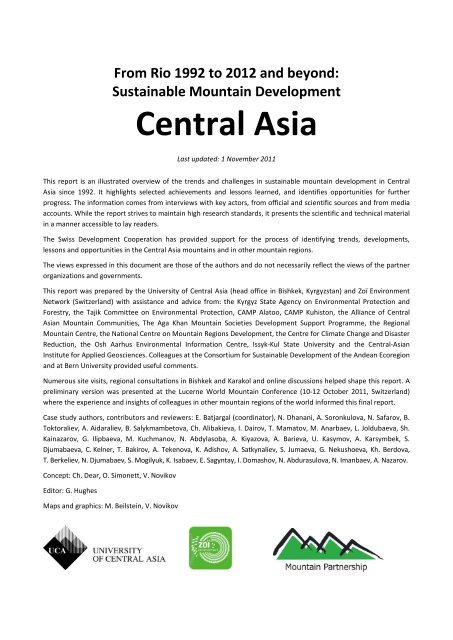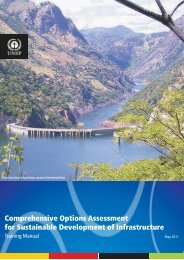Download - Rio+20
Download - Rio+20
Download - Rio+20
Create successful ePaper yourself
Turn your PDF publications into a flip-book with our unique Google optimized e-Paper software.
From Rio 1992 to 2012 and beyond:<br />
Sustainable Mountain Development<br />
Central Asia<br />
Last updated: 1 November 2011<br />
This report is an illustrated overview of the trends and challenges in sustainable mountain development in Central<br />
Asia since 1992. It highlights selected achievements and lessons learned, and identifies opportunities for further<br />
progress. The information comes from interviews with key actors, from official and scientific sources and from media<br />
accounts. While the report strives to maintain high research standards, it presents the scientific and technical material<br />
in a manner accessible to lay readers.<br />
The Swiss Development Cooperation has provided support for the process of identifying trends, developments,<br />
lessons and opportunities in the Central Asia mountains and in other mountain regions.<br />
The views expressed in this document are those of the authors and do not necessarily reflect the views of the partner<br />
organizations and governments.<br />
This report was prepared by the University of Central Asia (head office in Bishkek, Kyrgyzstan) and Zoï Environment<br />
Network (Switzerland) with assistance and advice from: the Kyrgyz State Agency on Environmental Protection and<br />
Forestry, the Tajik Committee on Environmental Protection, CAMP Alatoo, CAMP Kuhiston, the Alliance of Central<br />
Asian Mountain Communities, The Aga Khan Mountain Societies Development Support Programme, the Regional<br />
Mountain Centre, the National Centre on Mountain Regions Development, the Centre for Climate Change and Disaster<br />
Reduction, the Osh Aarhus Environmental Information Centre, Issyk-Kul State University and the Central-Asian<br />
Institute for Applied Geosciences. Colleagues at the Consortium for Sustainable Development of the Andean Ecoregion<br />
and at Bern University provided useful comments.<br />
Numerous site visits, regional consultations in Bishkek and Karakol and online discussions helped shape this report. A<br />
preliminary version was presented at the Lucerne World Mountain Conference (10-12 October 2011, Switzerland)<br />
where the experience and insights of colleagues in other mountain regions of the world informed this final report.<br />
Case study authors, contributors and reviewers: E. Batjargal (coordinator), N. Dhanani, A. Soronkulova, N. Safarov, B.<br />
Toktoraliev, A. Aidaraliev, B. Salykmambetova, Ch. Alibakieva, I. Dairov, T. Mamatov, M. Anarbaev, L. Joldubaeva, Sh.<br />
Kainazarov, G. Ilipbaeva, M. Kuchmanov, N. Abdylasoba, A. Kiyazova, A. Barieva, U. Kasymov, A. Karsymbek, S.<br />
Djumabaeva, C. Kelner, T. Bakirov, A. Tekenova, K. Adishov, A. Satkynaliev, S. Jumaeva, G. Nekushoeva, Kh. Berdova,<br />
T. Berkeliev, N. Djumabaev, S. Mogilyuk, K. Isabaev, E. Sagyntay, I. Domashov, N. Abdurasulova, N. Imanbaev, A. Nazarov.<br />
Concept: Ch. Dear, O. Simonett, V. Novikov<br />
Editor: G. Hughes<br />
Maps and graphics: M. Beilstein, V. Novikov
















